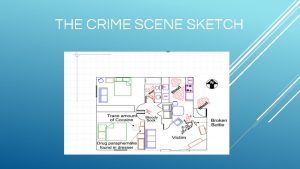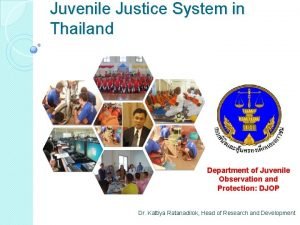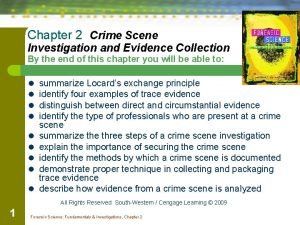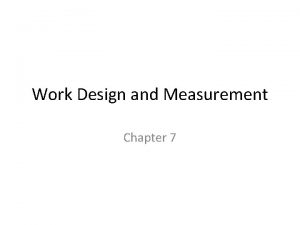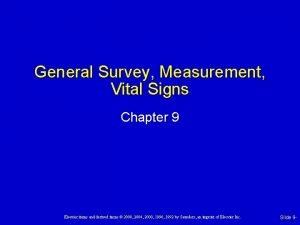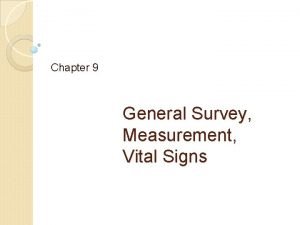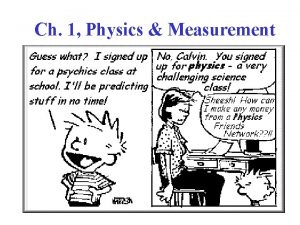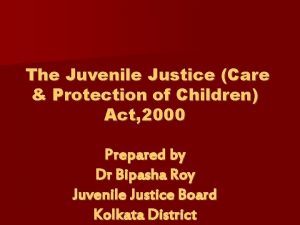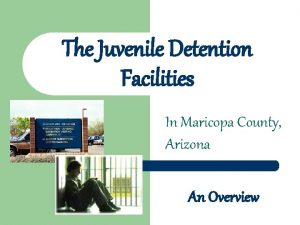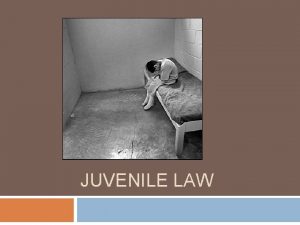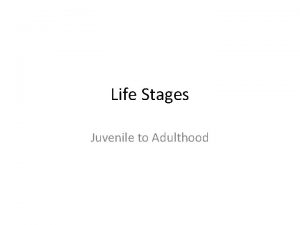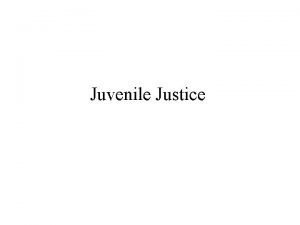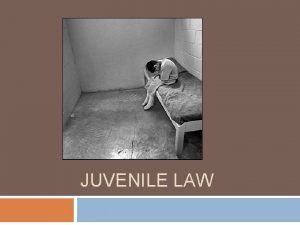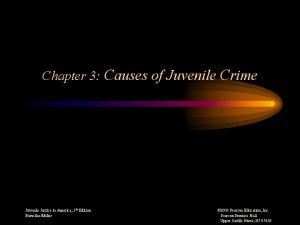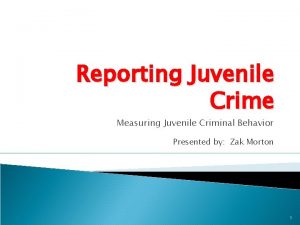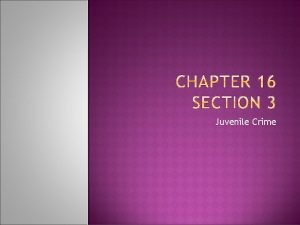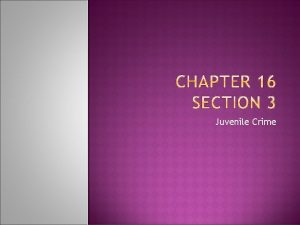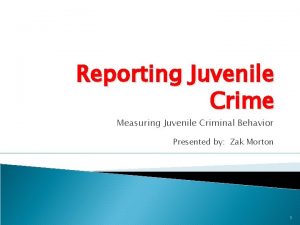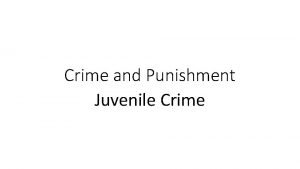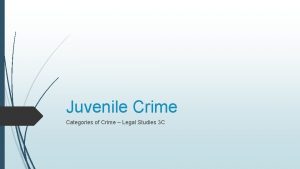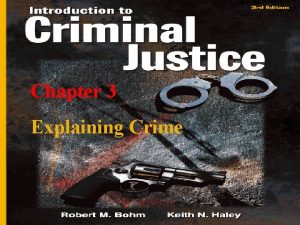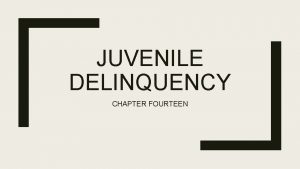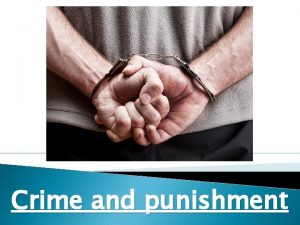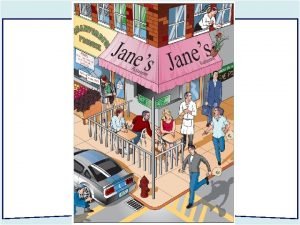Chapter 2 The Measurement of Juvenile Crime and

























































- Slides: 57

Chapter 2: The Measurement of Juvenile Crime and Victimization Juvenile Justice in America, 5 th Edition Bartollas/Miller © 2008 Pearson Education, Inc. Pearson Prentice Hall Upper Saddle River, NJ 07458

Outline • How and What Do We Know about Juveniles? The Measurement of Juvenile Crime – What Do We Know about the Extent of Juvenile Crime? • Uniform Crime Reports – Juvenile Court Statistics – Victimization Surveys • What Are the Self-Report and Cohort Measures of Juvenile Crime? – Self-Report Studies – Cohort Studies Juvenile Justice in America, 5 th Edition Bartollas/Miller © 2008 Pearson Education, Inc. Pearson Prentice Hall Upper Saddle River, NJ 07458

Outline (cont. ) • What Are the Dimensions of Law-Violating Behaviors? – – – Age of Onset Escalation of Offenses Specialization of Offenses Desistance from Crime Transition to Adult Behavior • From Where Do Juvenile Victims Come? – The Family and the Victimization of Children – The School and Victimization Juvenile Justice in America, 5 th Edition Bartollas/Miller © 2008 Pearson Education, Inc. Pearson Prentice Hall Upper Saddle River, NJ 07458

Objectives 1. To examine the extent of official juvenile lawbreaking 2. To reveal the findings of unofficial studies of juvenile lawbreaking 3. To compare official and unofficial findings of juvenile lawbreaking 4. To explore the extent to which juveniles are the victims of crime Juvenile Justice in America, 5 th Edition Bartollas/Miller © 2008 Pearson Education, Inc. Pearson Prentice Hall Upper Saddle River, NJ 07458

1. What are the types of official measurements of juvenile crime? Juvenile Justice in America, 5 th Edition Bartollas/Miller © 2008 Pearson Education, Inc. Pearson Prentice Hall Upper Saddle River, NJ 07458

Hints (pp. 35– 36): Ø Official measurements: The Uniform Crime Reports, juvenile court statistics, and national victimization surveys are three main sources. Ø The Uniform Crime Reports and juvenile court statistics are based on the tabulation of data collected from the police and juvenile courts. Ø National victimization surveys ask respondents to tell about the crimes committed against them. Juvenile Justice in America, 5 th Edition Bartollas/Miller © 2008 Pearson Education, Inc. Pearson Prentice Hall Upper Saddle River, NJ 07458

2. What is the UCR and its findings? Juvenile Justice in America, 5 th Edition Bartollas/Miller © 2008 Pearson Education, Inc. Pearson Prentice Hall Upper Saddle River, NJ 07458

Uniform Crime Reports (UCR) Ø Authorized by Congress in 1930 and designated the FBI to implement the program. Based on efforts started by the International Association of Chief’s of Police. Ø Divides crime into two parts: Part I and Part II. Ø Part I crimes are considered more serious and cover 8 offenses, which are further divided along violent and property crimes. The violent offenses include murder, rape, robbery, and aggravated assault. Property offenses include burglary, larceny, motor vehicle theft and arson (added in 1979). Ø Part II crimes are considered less serious offenses and are recorded by arrest only. Examples of Part II crimes include simple assault, forgery, embezzlement, vandalism, sex offenses (statutory rape), gambling, and prostitution. Juvenile Justice in America, 5 th Edition Bartollas/Miller © 2008 Pearson Education, Inc. Pearson Prentice Hall Upper Saddle River, NJ 07458

Ø Crime data reported to the FBI from local law enforcement agencies. Ø In its first year, the FBI collected data from 400 cities in 23 states. Today, nearly 16, 000 agencies report data to the FBI. Ø Crime data in converted into rates per 100, 000 people to allow for meaningful temporal and geographical comparisons. Ø For example, in 2005, the murder rate was 5. 6, rape was 32. 2, robbery was 150. 8, and aggravated assault was 291. 1. Burglary was 750. 2, Larceny was 2, 286. 3, motor vehicle theft was 416. 7, and arson was 26. 9. Juvenile Justice in America, 5 th Edition Bartollas/Miller © 2008 Pearson Education, Inc. Pearson Prentice Hall Upper Saddle River, NJ 07458

UCR Data Hints (pp. 35– 39): UCR arrest data from 2004 Ø Sex: What is the ratio of female to male arrests? Ø Females accounted for 477, 000 arrests, whereas males accounted for 1, 121, 000. Ø Males committed 82. 2% of violent crime and 68% of property crimes Ø Race: Different minority groups compared to whites? Ø Ø White juveniles accounted for 69% of arrests. African-Americans for 29% American-Indian 1. 2% Asian-Americans 1. 2% Juvenile Justice in America, 5 th Edition Bartollas/Miller © 2008 Pearson Education, Inc. Pearson Prentice Hall Upper Saddle River, NJ 07458

Ø Drugs: What are the most recent trends? Ø Arrests for drug use has increased in past decade Ø Arrests are typically for possession rather than sale. Ø Cocaine and Opium use has decline while marijuana use has increased. Ø Juvenile arrest rates overall have dropped 22% from 1995. Ø Homicide arrests have dropped dramatically since 1995. Juvenile Justice in America, 5 th Edition Bartollas/Miller © 2008 Pearson Education, Inc. Pearson Prentice Hall Upper Saddle River, NJ 07458

Ø Homicide: What are the most recent trends? Ø In 2002, on average, there were four juveniles murdered daily in the United States. Ø The murder rate for African-American youth was four times higher than for whites. Ø Nearly half of all juvenile murders (48%) were by handguns. Ø Person aged between 7 -17 are just as likely to be a victim of suicide as homicide. Ø Between 1980 and 2001, for every 10 white juveniles murder, 26 were suicide victims. In contrast, for every 10 African-Americans murdered, only one was a suicide victim. Ø In 2004, juveniles represented 10. 5% of all murder arrests. Juvenile Justice in America, 5 th Edition Bartollas/Miller © 2008 Pearson Education, Inc. Pearson Prentice Hall Upper Saddle River, NJ 07458

UCR limitations Ø Based on crimes reported to the police. Leads to underestimation. Ø Police typically arrest offenders to commit serious crimes and not minor ones. Ø Crime rates may appear inflated because youthful offenders are easier to catch. Ø Because youth generally commit crimes in groups, the reporting of all the groups’ crimes may overestimate youth crime. Ø Due to the hierarchy rule, only the most serious crime is counted. Juvenile Justice in America, 5 th Edition Bartollas/Miller © 2008 Pearson Education, Inc. Pearson Prentice Hall Upper Saddle River, NJ 07458

3. What are juvenile court statistics, and what do they cover? Juvenile Justice in America, 5 th Edition Bartollas/Miller © 2008 Pearson Education, Inc. Pearson Prentice Hall Upper Saddle River, NJ 07458

Hints (pp. 40– 42): Ø When and why were they developed? Ø Ø Developed in 1929 To learn about the nature and extent of problems coming before the court. To show nature and extent of services provided by the court so trends could be identified. To show the extent that the services have been effective. Ø What are status offenses? Behaviors for which juveniles, but not adults, could be arrested for. Examples include: truancy, running away, curfew violations, etc. Ø What are delinquency offenses? Criminal conduct in violation of law, such as robbery, theft, rape, etc. Juvenile Justice in America, 5 th Edition Bartollas/Miller © 2008 Pearson Education, Inc. Pearson Prentice Hall Upper Saddle River, NJ 07458

Ø What are some of the main findings of the JCS? Ø Delinquency increases with age Ø Juvenile courts process four times as many cases in 2002 than in 1960. Ø Ungovernability and truancy declines at age 15, but liquor law violations continue to increase. Ø Males are referred to the juvenile court more frequently than females. Ø Females are referred to the juvenile court for truancy and ungovernability at the same rate as males, though female rates are increasing relative to males. Ø White males are referred to juvenile court in numbers relative to their proportion of the population, but African-American were referred at rates disproportionately higher than their numbers in the population. Juvenile Justice in America, 5 th Edition Bartollas/Miller © 2008 Pearson Education, Inc. Pearson Prentice Hall Upper Saddle River, NJ 07458

Limitations of Juvenile Court Statistics Ø Time lag in the publication of statistic limits their usefulness. Ø Cases referred to court make up only a small portion of overall youth crime. Ø Provides only limited information on the characteristics of referred juveniles. Ø Estimates provided only give an estimate of the total cases brought before the courts. Juvenile Justice in America, 5 th Edition Bartollas/Miller © 2008 Pearson Education, Inc. Pearson Prentice Hall Upper Saddle River, NJ 07458

4. What are victimization surveys? How are they conducted? Juvenile Justice in America, 5 th Edition Bartollas/Miller © 2008 Pearson Education, Inc. Pearson Prentice Hall Upper Saddle River, NJ 07458

Hints (pp. 42– 44): Ø The National Victimization Survey Ø Started in 1972. Differs from the UCR because it consists of information elicited through interviews from randomly selected households. Ø Data gathered by the U. S. Census Bureau who survey approximately 42, 000 households, consisting of nearly 72, 000 people aged 12 and up. Interviews are conducted at 6 month intervals. Ø Interviewers are trained to collect household victimization data from anyone older than 12. Ø Considered a superior measure of crime because it includes crimes not reported to police. Ø Data collected covers more crimes and elicits more background information about the victim, suspect, and circumstances. Juvenile Justice in America, 5 th Edition Bartollas/Miller © 2008 Pearson Education, Inc. Pearson Prentice Hall Upper Saddle River, NJ 07458

5. What are some of their findings? Juvenile Justice in America, 5 th Edition Bartollas/Miller © 2008 Pearson Education, Inc. Pearson Prentice Hall Upper Saddle River, NJ 07458

Hints (pp. 42– 44): Ø Compare to UCRs Ø More crime is committed than is reported. Ø Amount of crime reported Ø In 2004, persons 12 years or older reported nearly 24 million crimes. Ø 18. 6 million were property crimes Ø 5. 2 million were violent crimes Ø Approximately 224, 000 were personnel thefts. Juvenile Justice in America, 5 th Edition Bartollas/Miller © 2008 Pearson Education, Inc. Pearson Prentice Hall Upper Saddle River, NJ 07458

Ø Chances of victimization Ø Youth between ages 16 -19 had the highest victimization rate than any other age group in the survey for violent crimes. Ø Adolescents were more likely to commit violent crimes against their peers than adults. Ø Probability of victimization varies with the type of crime and place of residence. City centers experience higher levels of violent crime. Juvenile Justice in America, 5 th Edition Bartollas/Miller © 2008 Pearson Education, Inc. Pearson Prentice Hall Upper Saddle River, NJ 07458

Limitations of Victimization Surveys Ø Limitations Ø Information on status offenses are not included. Ø Victims may forget victimizations they experienced. Ø Victims may mistakenly state they were a victim of a crime during a different year. Juvenile Justice in America, 5 th Edition Bartollas/Miller © 2008 Pearson Education, Inc. Pearson Prentice Hall Upper Saddle River, NJ 07458

6. What are the unofficial measures of juvenile crime? Discuss them. Juvenile Justice in America, 5 th Edition Bartollas/Miller © 2008 Pearson Education, Inc. Pearson Prentice Hall Upper Saddle River, NJ 07458

• Unofficial measurements (pp. 44– 49): ØSelf-report ØCohort studies Juvenile Justice in America, 5 th Edition Bartollas/Miller © 2008 Pearson Education, Inc. Pearson Prentice Hall Upper Saddle River, NJ 07458

7. What are the differences between a selfreport study and a cohort study? Juvenile Justice in America, 5 th Edition Bartollas/Miller © 2008 Pearson Education, Inc. Pearson Prentice Hall Upper Saddle River, NJ 07458

Hints (pp. 44– 46): Ø Self-report studies: Ask juveniles to tell about offenses they have committed in a previous period of time. Ø Cohort studies identify every juvenile born in a certain time frame in a particular city and then follow them for many years. Juvenile Justice in America, 5 th Edition Bartollas/Miller © 2008 Pearson Education, Inc. Pearson Prentice Hall Upper Saddle River, NJ 07458

8. Why are self-report studies important? What are their findings? Juvenile Justice in America, 5 th Edition Bartollas/Miller © 2008 Pearson Education, Inc. Pearson Prentice Hall Upper Saddle River, NJ 07458

Hints (pp. 44– 46): Ø Compare with UCRs Ø Compared with UCRs, self-report studies provide a fuller and more accurate picture of crime. Ø Race Ø Differences between races are not as large as official statistics portray. Ø Sex Ø Differential in arrest rates less than officially reported. Ø Females less likely to be involved in serious crime. Juvenile Justice in America, 5 th Edition Bartollas/Miller © 2008 Pearson Education, Inc. Pearson Prentice Hall Upper Saddle River, NJ 07458

Ø Social class and delinquency Ø Some research has indicated that no links exists between social class and delinquency. Ø However, a national study by Elliott and Ageton found that differences did exist and that lower class juveniles committed more delinquent acts that middle and upper class youth. Ø The same study found that the number of violent crimes committed by lower class youth was 1 ½ times greater than middle and upper class youth. Juvenile Justice in America, 5 th Edition Bartollas/Miller © 2008 Pearson Education, Inc. Pearson Prentice Hall Upper Saddle River, NJ 07458

What do self reports tell us about crime? Ø A significant amount of crime goes undetected in the U. S. Ø Middle class juveniles are involved in a considerable amount of crime. Ø Hidden delinquency hides a large number of hidden crimes not discovered by police. Ø The crime gap between white and African-Americans is smaller than official statistics indicate. Ø Girls commit more delinquent acts than are reported in official statistics. Juvenile Justice in America, 5 th Edition Bartollas/Miller © 2008 Pearson Education, Inc. Pearson Prentice Hall Upper Saddle River, NJ 07458

9. What are cohort studies and why are they important? Juvenile Justice in America, 5 th Edition Bartollas/Miller © 2008 Pearson Education, Inc. Pearson Prentice Hall Upper Saddle River, NJ 07458

Hints (pp. 46– 49): Ø Cohort studies often examine larger groups of people, all of whom were born in a specified time period. Ø They do not rely on institutionalized populations for data. Ø Cohort studies eliminate many confounding social variables that might affect study findings. Juvenile Justice in America, 5 th Edition Bartollas/Miller © 2008 Pearson Education, Inc. Pearson Prentice Hall Upper Saddle River, NJ 07458

10. What are some findings of cohort studies? Juvenile Justice in America, 5 th Edition Bartollas/Miller © 2008 Pearson Education, Inc. Pearson Prentice Hall Upper Saddle River, NJ 07458

Hints (p. 49): Ø How many youths commit what percent of crime? Ø In a 1945 and a 1958 study of all males in Philadelphia between the ages of 10 and 18, it was found that 6 -7% of the total cohorts committed slightly more than half the crime. Between 33% and 35% of both cohorts had at least one contact with police during the study period. Ø African-American youths vs. white youths Ø African-American urban youth committed more serious and frequent delinquent acts than whites. Ø Females vs. males Ø Females typically had fewer contacts and less serious offenses than males. Ø Drug use Ø A Denver cohort study of 1, 527 boys found that drugs use had declined dramatically. Ø However, the same study found that serious delinquents are using hard drugs, but that more hard drug users are serious offenders. Juvenile Justice in America, 5 th Edition Bartollas/Miller © 2008 Pearson Education, Inc. Pearson Prentice Hall Upper Saddle River, NJ 07458

Ø Progression of crimes Ø According to a cohort study conducted of 1, 517 youth in Pittsburg, offending by boys involved in serious offenses occurred by age 15. Ø In the same study, it was found that boys developed disruptive and delinquent behavior in a fairly order manner from less serious to more serious crimes. Ø Gangs and Crimes Ø A cohort study in Rochester, N. Y. , found a strong link between delinquency and gang membership. Also, associating with delinquent peers was strong correlated with delinquent activity. Juvenile Justice in America, 5 th Edition Bartollas/Miller © 2008 Pearson Education, Inc. Pearson Prentice Hall Upper Saddle River, NJ 07458

Limitations of Cohort Studies Ø Findings cannot be generalized beyond the persons in the cohort. Ø Cohort studies are extremely expensive and time-consuming. Juvenile Justice in America, 5 th Edition Bartollas/Miller © 2008 Pearson Education, Inc. Pearson Prentice Hall Upper Saddle River, NJ 07458

11. What are the dimensions of law-violating behaviors? Juvenile Justice in America, 5 th Edition Bartollas/Miller © 2008 Pearson Education, Inc. Pearson Prentice Hall Upper Saddle River, NJ 07458

Hints (pp. 49– 51): Ø Ø Ø The age of onset Escalation of numbers of offenses Specialization of offenses Desistance from crime Transition to adult crime Juvenile Justice in America, 5 th Edition Bartollas/Miller © 2008 Pearson Education, Inc. Pearson Prentice Hall Upper Saddle River, NJ 07458

• What is the age of onset? Juvenile Justice in America, 5 th Edition Bartollas/Miller © 2008 Pearson Education, Inc. Pearson Prentice Hall Upper Saddle River, NJ 07458

Hints (pp. 49– 50): Ø The age of onset is the age at which juveniles start their law-violating behaviors Ø One study found that as the age of onset increased, the average number of offenses decreased. Ø Another study found that offending at an early age was one factor that predicted who became a chronic offender. Ø Still another study reported that those convicted of offending at the earliest age (10 -12) offended at a higher rate and for a longer period of time. Juvenile Justice in America, 5 th Edition Bartollas/Miller © 2008 Pearson Education, Inc. Pearson Prentice Hall Upper Saddle River, NJ 07458

• What does the escalation of offenses mean? Juvenile Justice in America, 5 th Edition Bartollas/Miller © 2008 Pearson Education, Inc. Pearson Prentice Hall Upper Saddle River, NJ 07458

Hint (p. 50): Ø The escalation of offenses is an increase in the number of crimes committed by an individual. Ø Official statistics reveal that the incidence of arrest accelerates at age 13 and levels off at 17. This pattern is less evident in self-reports. Juvenile Justice in America, 5 th Edition Bartollas/Miller © 2008 Pearson Education, Inc. Pearson Prentice Hall Upper Saddle River, NJ 07458

• What is meant by specialization of offenses? Juvenile Justice in America, 5 th Edition Bartollas/Miller © 2008 Pearson Education, Inc. Pearson Prentice Hall Upper Saddle River, NJ 07458

Hint (p. 50): Ø The specialization of offenses is the tendency to repeat one type of crime. Ø Findings do not consistently show specialization among delinquents offenders. Ø However, one study found that status offenders were typically referred to the juvenile court 50 -70% of time for the same offense. Ø Female status offenders were most frequently referred for running away. Juvenile Justice in America, 5 th Edition Bartollas/Miller © 2008 Pearson Education, Inc. Pearson Prentice Hall Upper Saddle River, NJ 07458

• What is meant by desistance from crime? Juvenile Justice in America, 5 th Edition Bartollas/Miller © 2008 Pearson Education, Inc. Pearson Prentice Hall Upper Saddle River, NJ 07458

Hint (p. 50– 51): Ø Desistance from crime is the termination of delinquency. Ø Hard to measure exactly when a person stops offending. Juvenile Justice in America, 5 th Edition Bartollas/Miller © 2008 Pearson Education, Inc. Pearson Prentice Hall Upper Saddle River, NJ 07458

Theories regarding Desistance include: Ø Ø Ø Maturation and Aging Accounts Development Accounts: Cognitive shifts Rational Choice: Individual cost/benefit analysis of crime. Social Learning: We learn to be bad, we learn to be good. Life-Course: Occurs when defenders desist as a result of individual actions (choice) in conjunction with situational contexts and structural influences linked to key institutions that help sustain desistance. For example, going to college or joining the military. Juvenile Justice in America, 5 th Edition Bartollas/Miller © 2008 Pearson Education, Inc. Pearson Prentice Hall Upper Saddle River, NJ 07458

• Describe the transition to adult crime. To what is the transition related? Juvenile Justice in America, 5 th Edition Bartollas/Miller © 2008 Pearson Education, Inc. Pearson Prentice Hall Upper Saddle River, NJ 07458

Hint (p. 51): Ø Transition to adult crime is when juveniles who commit juvenile crime continue to commit crime as adults. The earlier juveniles start, the more likely they are to continue in crime as adults. Juvenile Justice in America, 5 th Edition Bartollas/Miller © 2008 Pearson Education, Inc. Pearson Prentice Hall Upper Saddle River, NJ 07458

12. What is childhood victimization and what are its types? Juvenile Justice in America, 5 th Edition Bartollas/Miller © 2008 Pearson Education, Inc. Pearson Prentice Hall Upper Saddle River, NJ 07458

Hints: Ø Numbers of children victimized Ø Reports have indicated that maltreatment of children has increased by 155% between 1980 and 1993. Childhood victimization leveled off between 1994 and 1999, but started to increase in 2000. Ø There were almost 3 million reports of abuse in 2000. Ø Many states require certain professions (teachers, doctors, police) to report child abuse. Juvenile Justice in America, 5 th Edition Bartollas/Miller © 2008 Pearson Education, Inc. Pearson Prentice Hall Upper Saddle River, NJ 07458

Categories of Maltreatment Ø Maltreatment falls into several categories: Ø Neglect (60%) Ø Physical Abuse (18%) Ø Sexual Abuse (10%) Ø Emotional Mistreatment (5%) Ø Other (15%): includes abandonment, drugs addiction, medical neglect. Juvenile Justice in America, 5 th Edition Bartollas/Miller © 2008 Pearson Education, Inc. Pearson Prentice Hall Upper Saddle River, NJ 07458

Ø Types of violence Ø Homicide is the most common victimization. UCR data for 2004 revealed that 1, 365 people under the age of 18 were murdered. Ø 79% percent of child murder victims were killed by their parents. Ø Females were twice as likely to be killed by family members than males. Ø Children under 8 were more likely to die from neglect. Ø Children over 8 were more likely to die from physical or sexual abuse. Ø Young children were more likely to die at the hands of a family members, while older children were more likely to be murdered by non-family members. Juvenile Justice in America, 5 th Edition Bartollas/Miller © 2008 Pearson Education, Inc. Pearson Prentice Hall Upper Saddle River, NJ 07458

13. What are the parameters of in-school victimization? Juvenile Justice in America, 5 th Edition Bartollas/Miller © 2008 Pearson Education, Inc. Pearson Prentice Hall Upper Saddle River, NJ 07458

Hints (pp. 54– 57): Ø Past vs. present: Ø Past: Most incidents of school misbehavior were minor, such as skipping school and running in the halls. Ø Present: Today, students are likely to face some of the same Ø Gangs: Ø Gangs members frequently bring guns to school. Ø They are regularly recruiting new members. Ø Conflict takes place when rival gangs are present. Juvenile Justice in America, 5 th Edition Bartollas/Miller © 2008 Pearson Education, Inc. Pearson Prentice Hall Upper Saddle River, NJ 07458

Ø Extent of victimization Ø According to UCR data, crime in school dropped from the mid-90’s through 2002. Ø 5% of all students report victimization. Ø Violent victimization is greater out of school than in school. Ø Less than 1% of students experience violent victimizations. Ø Types of victimization Ø Theft is committed at a rate of 45 out of a thousand students. Ø Violent crimes is committed at a rate of 28 out of a thousand students Ø Serious violent crime is committed at a rate of 3 out of a thousand students. Ø Types of schools in which found Ø Urban schools experience greater crime than rural schools. Juvenile Justice in America, 5 th Edition Bartollas/Miller © 2008 Pearson Education, Inc. Pearson Prentice Hall Upper Saddle River, NJ 07458
 Juvenile crime singapore
Juvenile crime singapore Outdoor crime scene sketch
Outdoor crime scene sketch Department of juvenile observation and protection
Department of juvenile observation and protection What is the nature and extent of juvenile delinquency
What is the nature and extent of juvenile delinquency Criminal law and juvenile justice unit 2
Criminal law and juvenile justice unit 2 Juvenile delinquency and poverty
Juvenile delinquency and poverty R a 9344
R a 9344 Chapter 7 deviance crime and social control
Chapter 7 deviance crime and social control Locard exchange principle
Locard exchange principle Hình ảnh bộ gõ cơ thể búng tay
Hình ảnh bộ gõ cơ thể búng tay Lp html
Lp html Bổ thể
Bổ thể Tỉ lệ cơ thể trẻ em
Tỉ lệ cơ thể trẻ em Chó sói
Chó sói Glasgow thang điểm
Glasgow thang điểm Bài hát chúa yêu trần thế alleluia
Bài hát chúa yêu trần thế alleluia Môn thể thao bắt đầu bằng chữ f
Môn thể thao bắt đầu bằng chữ f Thế nào là hệ số cao nhất
Thế nào là hệ số cao nhất Các châu lục và đại dương trên thế giới
Các châu lục và đại dương trên thế giới Công của trọng lực
Công của trọng lực Trời xanh đây là của chúng ta thể thơ
Trời xanh đây là của chúng ta thể thơ Cách giải mật thư tọa độ
Cách giải mật thư tọa độ 101012 bằng
101012 bằng Phản ứng thế ankan
Phản ứng thế ankan Các châu lục và đại dương trên thế giới
Các châu lục và đại dương trên thế giới Thơ thất ngôn tứ tuyệt đường luật
Thơ thất ngôn tứ tuyệt đường luật Quá trình desamine hóa có thể tạo ra
Quá trình desamine hóa có thể tạo ra Một số thể thơ truyền thống
Một số thể thơ truyền thống Cái miệng xinh xinh thế chỉ nói điều hay thôi
Cái miệng xinh xinh thế chỉ nói điều hay thôi Vẽ hình chiếu vuông góc của vật thể sau
Vẽ hình chiếu vuông góc của vật thể sau Nguyên nhân của sự mỏi cơ sinh 8
Nguyên nhân của sự mỏi cơ sinh 8 đặc điểm cơ thể của người tối cổ
đặc điểm cơ thể của người tối cổ Thế nào là giọng cùng tên
Thế nào là giọng cùng tên Vẽ hình chiếu đứng bằng cạnh của vật thể
Vẽ hình chiếu đứng bằng cạnh của vật thể Vẽ hình chiếu vuông góc của vật thể sau
Vẽ hình chiếu vuông góc của vật thể sau Thẻ vin
Thẻ vin đại từ thay thế
đại từ thay thế điện thế nghỉ
điện thế nghỉ Tư thế ngồi viết
Tư thế ngồi viết Diễn thế sinh thái là
Diễn thế sinh thái là Các loại đột biến cấu trúc nhiễm sắc thể
Các loại đột biến cấu trúc nhiễm sắc thể Bảng số nguyên tố lớn hơn 1000
Bảng số nguyên tố lớn hơn 1000 Tư thế ngồi viết
Tư thế ngồi viết Lời thề hippocrates
Lời thề hippocrates Thiếu nhi thế giới liên hoan
Thiếu nhi thế giới liên hoan ưu thế lai là gì
ưu thế lai là gì Hổ đẻ mỗi lứa mấy con
Hổ đẻ mỗi lứa mấy con Khi nào hổ mẹ dạy hổ con săn mồi
Khi nào hổ mẹ dạy hổ con săn mồi Sơ đồ cơ thể người
Sơ đồ cơ thể người Từ ngữ thể hiện lòng nhân hậu
Từ ngữ thể hiện lòng nhân hậu Thế nào là mạng điện lắp đặt kiểu nổi
Thế nào là mạng điện lắp đặt kiểu nổi Work measurement techniques
Work measurement techniques Measurement elsevier
Measurement elsevier Normal pediatric vitals by age
Normal pediatric vitals by age Base and derived quantities
Base and derived quantities Measurement 1 physics
Measurement 1 physics Care and protection of children act
Care and protection of children act Maricopa county juvenile detention
Maricopa county juvenile detention

